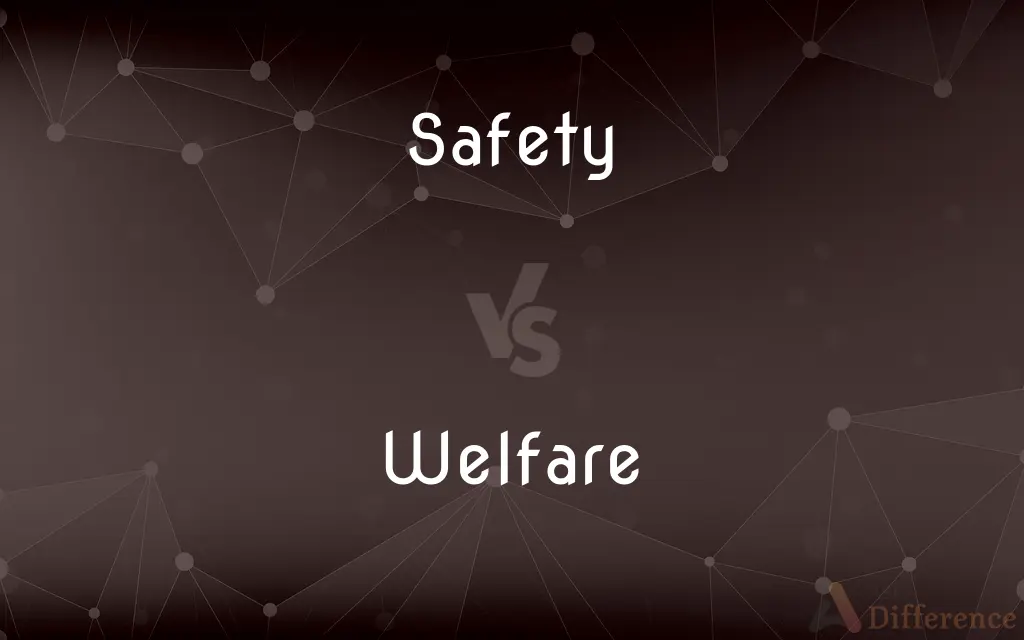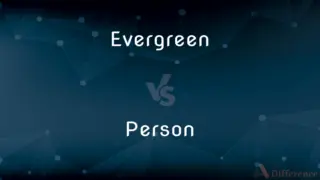Safety vs. Welfare — What's the Difference?
By Tayyaba Rehman & Maham Liaqat — Updated on April 5, 2024
Safety involves protecting from immediate harm or danger, focusing on prevention and immediate response. Welfare encompasses broader well-being, including health, happiness, and conditions of a good life.

Difference Between Safety and Welfare
Table of Contents
ADVERTISEMENT
Key Differences
Safety is primarily concerned with preventing accidents, injuries, and immediate harm in environments such as the workplace, public spaces, and homes. It involves measures and protocols to mitigate risks and ensure physical protection. Welfare, on the other hand, includes a broader spectrum of factors such as health, economic stability, and emotional well-being, aiming to improve the quality of life over the long term.
While safety measures are often enforced through regulations and guidelines by authorities to prevent specific risks, welfare programs are typically structured to provide support and resources to individuals and communities to address a wide range of needs including food, shelter, education, and healthcare.
Safety initiatives are reactive and proactive approaches to protect individuals from immediate dangers, like wearing helmets or implementing safety drills. Welfare, whereas, involves ongoing efforts to enhance living conditions, such as social security benefits and access to healthcare services, focusing on sustained well-being.
In the context of employment, safety protocols are designed to prevent workplace accidents and occupational diseases. Welfare in employment encompasses broader aspects like job satisfaction, work-life balance, and mental health support, aiming for holistic employee well-being.
While both safety and welfare are crucial for human well-being, safety often takes precedence in emergency and hazardous situations, where immediate action is necessary to prevent harm. Welfare, on the other hand, is a long-term commitment to improving and maintaining the quality of life, even in the absence of immediate dangers.
ADVERTISEMENT
Comparison Chart
Focus
Immediate harm prevention
Long-term well-being
Scope
Specific risks and dangers
Broad aspects of life including health, happiness, and prosperity
Implementation
Regulations, guidelines, and protective measures
Support programs, resources, and services
Examples
Safety drills, protective equipment, emergency protocols
Social security, healthcare access, education programs
Objective
To protect from accidents, injuries, and immediate dangers
To improve quality of life and ensure basic needs are met
Compare with Definitions
Safety
Procedures or devices designed to prevent harm.
Fire extinguishers are essential safety devices in homes and workplaces.
Welfare
A system that provides support to individuals.
The welfare system is designed to protect society's most vulnerable.
Safety
The condition of being protected from risk.
Safety measures were increased after the recent accident.
Welfare
The state of doing well in life.
The welfare of our employees is our top priority.
Safety
The state of feeling secure and not threatened.
The new security system was installed to enhance safety in the building.
Welfare
The health, happiness, and fortunes of a person or group.
Government welfare programs aim to support low-income families.
Safety
Protection against harm or danger.
The company emphasizes safety training for all new employees.
Welfare
Conditions that promote well-being.
The organization promotes animal welfare through its policies.
Safety
A strategy to prevent accidents and injuries.
Wearing helmets is a basic safety precaution for cyclists.
Welfare
Assistance for the needy.
Welfare benefits help many people afford basic living expenses.
Safety
Safety is the state of being "safe", the condition of being protected from harm or other danger. Safety can also refer to the control of recognized hazards in order to achieve an acceptable level of risk.
Welfare
Welfare is a type of government support intended to ensure that members of a society can meet basic human needs such as food and shelter. Social security may either be synonymous with welfare, or refer specifically to social insurance programs, which provide support only to those who have previously contributed (e.g.
Safety
The condition of being safe; freedom from danger, risk, or injury.
Welfare
The health, happiness, and fortunes of a person or group
They don't give a damn about the welfare of their families
Safety
A device designed to prevent accidents, as a lock on a firearm preventing accidental firing.
Welfare
Statutory procedure or social effort designed to promote the basic physical and material well-being of people in need
The protection of rights to education, housing, and welfare
Safety
A play in which a member of the offensive team downs the ball or is tackled or forced out of bounds behind his own goal line, resulting in two points for the defensive team.
Welfare
Health, happiness, and good fortune; well-being
Workers concerned with the welfare of their families.
Safety
Either of two defensive backs normally positioned behind the linebackers in the middle of the backfield.
Welfare
Financial or other aid provided, especially by the government, to people in need.
Safety
The condition or feeling of being safe; security; certainty.
If you push it to the limit, safety is not guaranteed.
Welfare
See welfare work.
Safety
(mechanics) A mechanism on a weapon or dangerous equipment designed to prevent accidental firing.
Be sure that the safety is set before proceeding.
Welfare
See corporate welfare.
Safety
(American football) An instance of a player being sacked or tackled in the end zone, or stepping out of the end zone and off the field, resulting in two points to the opposite team.
He sacked the quarterback in the end zone for a safety.
Welfare
(uncountable) Health, safety, happiness and prosperity; well-being in any respect.
Safety
(American football) Any of the defensive players who are in position furthest from the line of scrimmage and whose responsibility is to defend against passes as well as to be the tacklers of last resort.
The free safety made a game-saving tackle on the runner who had broken past the linebackers.
Welfare
Various forms of financial aid provided by the government to those who are in need of it (often called welfare assistance in UK English).
Safety
(baseball) A safety squeeze.
Welfare
Such payment.
Safety
Preservation from escape; close custody.
Welfare
(transitive) To provide with welfare or aid.
Welfaring the poor
Safety
(dated) A safety bicycle.
Welfare
Well-doing or well-being in any respect; the enjoyment of health and the common blessings of life; exemption from any evil or calamity; prosperity; happiness.
How to study for the people's welfare.
In whose deep eyesMen read the welfare of the times to come.
Safety
(transitive) To secure (a mechanical component, as in aviation) to keep it from becoming detached even under vibration.
Welfare
Governmental provision of economic assistance to persons in need
Safety
To secure a firing pin, as in guns, to keep the gun from firing
Welfare
Something that aids or promotes well-being;
For the common good
Safety
The condition or state of being safe; freedom from danger or hazard; exemption from hurt, injury, or loss.
Up led by thee,Into the heaven I have presumed,An earthly guest . . . With like safety guided down,Return me to my native element.
Welfare
A contented state of being happy and healthy and prosperous;
The town was finally on the upbeat after our recent troubles
Safety
Preservation from escape; close custody.
Imprison him, . . . Deliver him to safety; and return.
Safety
The act or result of a ball-carrier on the offensive team being tackled behind his own goal line, or the downing of a ball behind the offensive team's own goal line when it had been carried or propelled behind that goal line by a player on the offensive tream; such a play causes a score of two points to be awarded to the defensive team; - it is distinguished from touchback, when the ball is downed behind the goal after being propelled there or last touched by a player of the defending team. See Touchdown. Same as Safety touchdown, below.
Safety
Short for Safety bicycle.
Safety
A switch on a firearm that locks the trigger and prevents the firearm from being discharged unintentionally; - also called safety catch, safety lock, or lock.
Safety
The state of being certain that adverse effects will not be caused by some agent under defined conditions;
Insure the safety of the children
The reciprocal of safety is risk
Safety
A safe place;
He ran to safety
Safety
A device designed to prevent injury
Safety
(baseball) the successful act of striking a baseball in such a way that the batter reaches base safely
Safety
A score in American football; a player is tackled behind his own goal line
Common Curiosities
What is the primary goal of safety?
To prevent immediate harm and protect individuals from specific dangers.
How does welfare contribute to society?
Welfare contributes by improving overall well-being, supporting the needy, and enhancing quality of life.
What are common safety protocols in workplaces?
Safety training, emergency drills, and the use of protective equipment.
Is emotional well-being part of welfare?
Yes, emotional well-being is a crucial component of overall welfare.
How are safety regulations enforced?
Through legal requirements, inspections, and penalties for non-compliance.
Can welfare systems vary between countries?
Yes, welfare systems can vary widely in scope and implementation across different countries.
How do welfare programs support families?
By providing financial aid, healthcare, and education services.
How do businesses contribute to employee welfare?
Through health benefits, supportive work environments, and ensuring work-life balance.
Can safety measures impact welfare?
Yes, effective safety measures can directly contribute to the welfare by creating safer environments.
What role do governments play in welfare?
Governments design and fund programs to support the health, education, and financial stability of their citizens.
Are safety and welfare interconnected?
Yes, improvements in safety can enhance welfare by creating safer living and working conditions.
What is a welfare state?
A welfare state is a government that provides extensive welfare programs to its citizens.
What is a key difference between safety and welfare?
Safety focuses on preventing immediate dangers, while welfare encompasses overall well-being.
Why is safety considered a basic human right?
Because everyone deserves to live and work in environments that are free from unnecessary risks and dangers.
What are examples of safety equipment?
Helmets, safety goggles, and fire extinguishers.
Share Your Discovery

Previous Comparison
Evergreen vs. Person
Next Comparison
Gravel vs. AggregateAuthor Spotlight
Written by
Tayyaba RehmanTayyaba Rehman is a distinguished writer, currently serving as a primary contributor to askdifference.com. As a researcher in semantics and etymology, Tayyaba's passion for the complexity of languages and their distinctions has found a perfect home on the platform. Tayyaba delves into the intricacies of language, distinguishing between commonly confused words and phrases, thereby providing clarity for readers worldwide.
Co-written by
Maham Liaqat













































